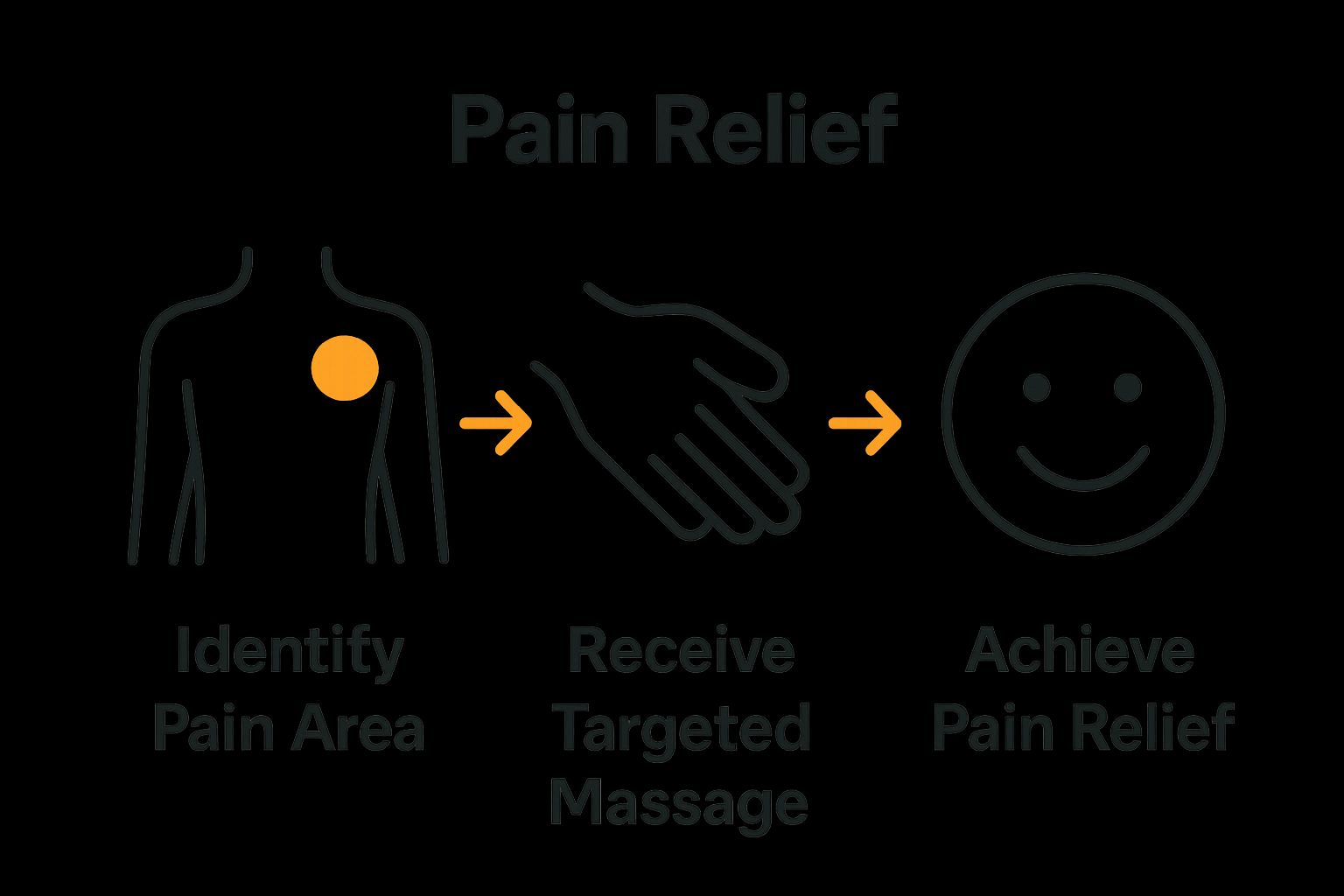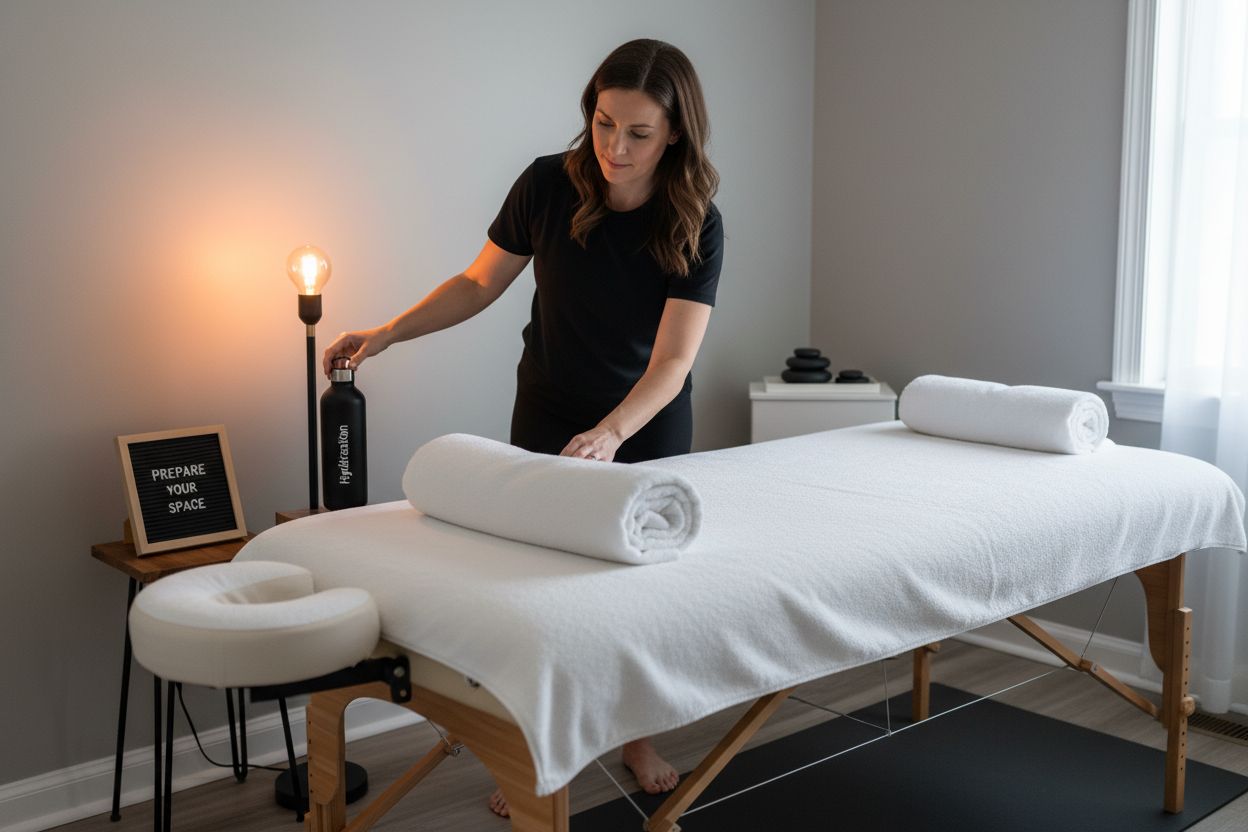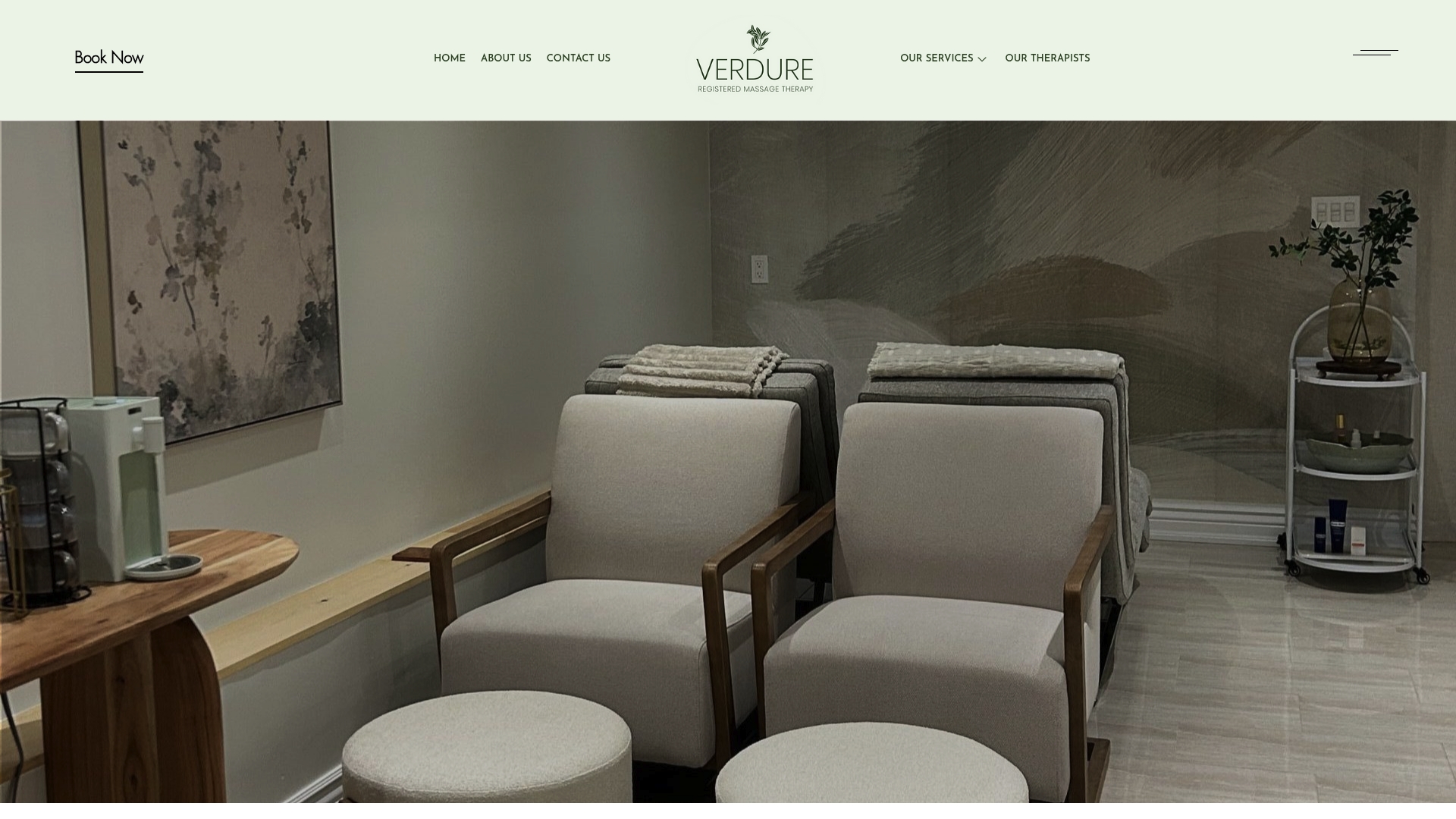Therapeutic massage is often seen as a quick fix for sore muscles or stubborn back pain. But studies show that tracking pain characteristics and patterns before your first session can lead to significantly better outcomes. Most people focus on selecting the right massage style or finding a nearby therapist, yet the surprising truth is that your own self-assessment matters just as much as any hands-on technique for lasting relief.
Table of Contents
- Step 1: Identify Your Pain Points And Symptoms
- Step 2: Choose The Right Therapeutic Massage Technique
- Step 3: Prepare Your Space And Gather Supplies
- Step 4: Schedule Your Appointment With A Professional
- Step 5: Communicate Your Needs During The Session
- Step 6: Evaluate Your Relief And Next Steps
Quick Summary
| Key Point | Explanation |
|---|---|
| 1. Identify pain characteristics thoroughly | Track pain location, quality, and triggers to inform your massage therapist effectively. |
| 2. Choose the right massage technique | Match your pain type with techniques like deep tissue or Swedish for effective relief. |
| 3. Communicate openly during the session | Share comfort levels and sensations to ensure a tailored and effective massage experience. |
| 4. Evaluate relief after each session | Assess pain changes and emotional states post-massage to determine ongoing treatment needs. |
| 5. Prepare your environment properly | Optimize room temperature, comfort, and lighting to enhance relaxation and pain relief during massage. |
Step 1: Identify Your Pain Points and Symptoms
Understanding the specific nature of your pain is crucial when seeking therapeutic massage for pain relief. Before scheduling a massage, you need to conduct a thorough self-assessment of your physical discomfort to help your massage therapist create the most effective treatment plan.
Begin by carefully tracking your pain characteristics. Location matters significantly. Is the pain concentrated in a specific area like your lower back, neck, shoulders, or does it radiate across multiple muscle groups? Note the precise regions where you experience tension, stiffness, or sharp sensations. Consider keeping a pain journal for several days to document the intensity, duration, and potential triggers of your discomfort.
Pay close attention to the quality of your pain. Different sensations provide critical insights for your massage therapist. Sharp, stabbing pain might indicate muscle strain or nerve compression. Dull, persistent aches could suggest chronic tension or underlying musculoskeletal issues. Burning or tingling sensations might point to nerve involvement. Documenting these nuances helps create a comprehensive picture of your physical condition.
Consider documenting additional contextual details that might influence your pain experience. Examine how your pain changes throughout the day. Does sitting for long periods exacerbate your discomfort? Do you notice increased tension after specific activities like working at a computer, exercising, or during stressful periods? Understanding these patterns helps your massage therapist design a targeted therapeutic approach.
Physical assessment goes beyond just identifying pain. Evaluate your range of motion and flexibility.
 Can you turn your head fully without discomfort? Do certain movements trigger pain or stiffness? These observations provide valuable information about potential muscle imbalances or restricted mobility that therapeutic massage can address.
Can you turn your head fully without discomfort? Do certain movements trigger pain or stiffness? These observations provide valuable information about potential muscle imbalances or restricted mobility that therapeutic massage can address.
Finally, reflect on your overall physical and emotional state. Stress, anxiety, and poor sleep can significantly impact muscle tension and pain perception. By providing a holistic view of your health, you enable your massage therapist to develop a more comprehensive treatment strategy that addresses both physical symptoms and underlying wellness factors.
Key Verification Checklist:
- Detailed pain location mapped
- Pain characteristics documented
- Movement restrictions identified
- Potential pain triggers noted
- Overall physical and emotional context recorded
Step 2: Choose the Right Therapeutic Massage Technique
Selecting the appropriate massage technique is a critical step in achieving effective pain relief. Each therapeutic massage approach offers unique benefits tailored to specific pain conditions and physical needs. Your goal is to match the most suitable technique with your identified pain points and symptoms.
Deep tissue massage emerges as an excellent option for individuals experiencing chronic muscle tension or persistent pain. This technique involves applying firm pressure and slow strokes to reach deeper muscle layers and connective tissue. Ideal for targeting stubborn knots and adhesions, deep tissue massage helps break down scar tissue and restore normal muscle function. If you have accumulated tension from prolonged sitting, repetitive work movements, or athletic training, this technique can provide significant relief.
Learn more about understanding different massage styles to help you make an informed decision. Swedish massage represents another powerful option, particularly for those experiencing mild to moderate muscle discomfort and seeking overall relaxation. Characterized by lighter, flowing strokes and gentle kneading, this technique promotes circulation, reduces muscle tension, and supports the body’s natural healing processes.
Consider your personal comfort and pain tolerance when selecting a massage technique. Some individuals might find deep tissue massage too intense, while others may require its more aggressive approach. Communication with your massage therapist becomes paramount. During your initial consultation, be transparent about your pain levels, medical history, and specific physical limitations. A skilled therapist will help you navigate these considerations and recommend the most appropriate technique.
Specialty techniques like myofascial release or trigger point therapy can offer targeted solutions for specific pain conditions. Myofascial release focuses on relieving tension in the fascia, the connective tissue surrounding muscles, while trigger point therapy targets precise areas of muscle tension that can refer pain to other body regions. These approaches are particularly beneficial for individuals with complex or persistent pain patterns.
Below is a comparison table to help you quickly understand the different therapeutic massage techniques mentioned and their ideal uses.
| Massage Technique | Best For | Pressure Level | Key Benefits |
|---|---|---|---|
| Deep Tissue | Chronic muscle tension, knots | Firm/Intense | Targets deep layers, breaks adhesions |
| Swedish | Mild/moderate discomfort, relaxation | Light to moderate | Promotes circulation, full-body relaxation |
| Myofascial Release | Persistent or complex pain | Gentle to moderate | Releases fascial tension, improves mobility |
| Trigger Point Therapy | Localized, radiating pain | Variable | Deactivates trigger points, relieves referred pain |
Key Verification Checklist:
- Massage technique matches specific pain symptoms
- Personal comfort level considered
- Therapist consultation completed
- Technique’s specific benefits understood
- Potential contraindications evaluated
Step 3: Prepare Your Space and Gather Supplies
Creating the optimal environment for therapeutic massage is crucial for maximizing pain relief and relaxation. Your preparation can significantly enhance the effectiveness of your massage experience, whether you are receiving treatment at home or preparing for a professional session.
Temperature and comfort are fundamental elements of your massage preparation. Choose a space that maintains a consistently warm temperature between 70 to 75 degrees Fahrenheit. This range helps muscles remain relaxed and prevents unnecessary tension from feeling cold. If you are preparing a home massage area, consider using a small space heater or ensuring the room has minimal drafts. Soft, layered blankets or towels provide additional warmth and comfort, allowing you to adjust your coverage as needed during the massage.
Explore our guide for massage therapy beginners to understand additional preparation techniques. Gathering the right supplies transforms your massage experience from basic to therapeutic. Essential items include clean, soft towels, a massage table or firm, flat surface like a massage mat, and comfortable pillows for supporting different body positions. If you have specific areas of pain, consider having additional supportive cushions or rolled towels to help maintain proper body alignment during the massage.
Lighting plays a subtle but significant role in creating a relaxing atmosphere. Soft, diffused lighting helps reduce visual stimulation and promotes relaxation. Avoid harsh overhead lights. Instead, use table lamps, dimmer switches, or candles to create a soothing ambiance. Consider using essential oils or a subtle diffuser to enhance the sensory experience, choosing calming scents like lavender or chamomile that can further support muscle relaxation.
Prepare yourself physically by wearing loose, comfortable clothing that can be easily removed or adjusted. Hydration is key before and after massage, so have water nearby.
 If you are working with a professional massage therapist, communicate any specific needs or preferences about room temperature, lighting, or music beforehand. This ensures a personalized, comfortable experience tailored to your specific requirements.
If you are working with a professional massage therapist, communicate any specific needs or preferences about room temperature, lighting, or music beforehand. This ensures a personalized, comfortable experience tailored to your specific requirements.
Key Verification Checklist:
- Room temperature optimized
- Massage surface prepared
- Supportive accessories gathered
- Lighting adjusted for relaxation
- Hydration and comfort priorities addressed
Step 4: Schedule Your Appointment with a Professional
Scheduling your therapeutic massage appointment requires strategic planning and careful consideration to ensure you receive the most effective treatment for your specific pain conditions. The goal is to connect with a qualified massage therapist who understands your unique physical needs and can provide targeted relief.
Research and credentials matter significantly when selecting a massage professional. Look for Registered Massage Therapists (RMTs) with specialized training and experience addressing your specific pain symptoms. Check professional credentials, read client testimonials, and verify their expertise in the specific massage techniques you require. Many professional therapists offer initial consultations where you can discuss your pain points and determine compatibility before committing to a full session.
Learn more about personalized massage therapy approaches to help guide your selection process. When contacting potential massage therapists, prepare a concise summary of your pain history. Be prepared to discuss the location, intensity, and duration of your pain, along with any medical conditions or previous treatments. This information helps the therapist design a customized treatment plan that addresses your specific needs.
Consider practical logistics when scheduling your appointment. Choose a time when you can fully relax without immediate work or stress obligations afterward. Many people find morning or early evening appointments work best, allowing time for post-massage recovery. Some therapists recommend scheduling massage sessions when you can minimize physical strain immediately following the treatment, enabling your body to integrate the therapeutic work.
Financial considerations are also important. Confirm pricing, session duration, and whether your health insurance covers massage therapy. Many extended health plans provide partial reimbursement for RMT services. Ask about package deals or initial assessment rates that might offer more affordable options. Some clinics also provide sliding scale pricing or introductory session discounts for new clients.
Key Verification Checklist:
- Therapist credentials verified
- Pain history summary prepared
- Appointment time selected
- Financial arrangements confirmed
- Treatment goals clearly communicated
Step 5: Communicate Your Needs During the Session
Effective communication during your therapeutic massage session is the cornerstone of achieving optimal pain relief and ensuring a positive, healing experience. Your ability to articulate your needs, preferences, and physical responses will directly impact the quality and effectiveness of the treatment.
Comfort and boundaries are paramount in any massage therapy session. From the moment you arrive, establish clear expectations with your massage therapist. Be upfront about your pain tolerance, specific areas of sensitivity, and any physical limitations. If certain pressure levels cause discomfort or if a particular technique feels too intense, communicate this immediately. Learn more about effective communication during massage therapy to enhance your overall experience.
During the massage, maintain an ongoing dialogue with your therapist. Use clear, descriptive language to explain your sensations. Instead of saying “that hurts,” try to specify the type of pain or discomfort. For example, describe whether the sensation is sharp, dull, burning, or merely uncomfortable. This detailed feedback helps your therapist adjust their technique in real-time, ensuring the massage remains both therapeutic and comfortable.
Non-verbal communication is equally important. Pay attention to your body’s responses and be prepared to signal your therapist through agreed-upon methods. Some clients use a hand gesture or a specific word to indicate when pressure needs adjustment. If you feel any sharp or sudden pain, communicate this immediately. A professional massage therapist will always prioritize your comfort and be willing to modify their approach.
Be open about your overall health and any changes in your physical condition. If you’ve experienced new injuries, increased stress, or changes in medication since your last session, share these details. Such information helps your therapist adapt their technique to your current physical state, ensuring a safe and effective massage experience.
Key Verification Checklist:
- Boundaries and comfort levels clearly communicated
- Specific pain and pressure preferences discussed
- Non-verbal communication methods established
- Ongoing feedback provided during session
- Health updates shared with massage therapist
Step 6: Evaluate Your Relief and Next Steps
After your therapeutic massage session, a comprehensive evaluation of your physical response and pain relief is crucial for understanding the treatment’s effectiveness and planning future wellness strategies. This step transforms your massage experience from a single intervention into a holistic approach to pain management.
Immediate post-massage assessment is essential for tracking your body’s response. Pay careful attention to how you feel in the hours following your massage. Some individuals experience immediate pain reduction, while others might notice gradual improvement over 24 to 48 hours. Learn more about tracking your healthcare experiences to help document your progress effectively.
Document your physical sensations meticulously. Note changes in pain intensity, range of motion, and overall mobility. Record any areas of residual tension or new sensations. Some muscle groups might feel temporarily sore, which is normal and indicates that deep therapeutic work has occurred. However, distinguish between expected post-massage tenderness and potential signs of strain or inappropriate pressure.
Consider your overall physical and emotional state. Therapeutic massage impacts more than just muscle tension. Observe improvements in sleep quality, stress levels, and general energy. Many individuals report enhanced mental clarity and reduced anxiety following massage therapy. These holistic benefits are as important as physical pain relief in your wellness journey.
Consult with your massage therapist about developing a consistent treatment plan. Depending on your specific pain conditions, they might recommend follow-up sessions at regular intervals. Some chronic pain conditions require a series of treatments to achieve sustained relief. Your therapist can help you understand the optimal frequency of massage therapy tailored to your individual health needs.
This checklist table summarizes key verification points you should complete for each step to ensure an effective therapeutic massage process.
| Step | Verification Checklist Item |
|---|---|
| Identify Pain Points & Symptoms | Pain location mapped; Quality documented; Movement restrictions noted; Pain triggers considered; Overall context recorded |
| Choose Massage Technique | Technique matches symptoms; Comfort level considered; Therapist consulted; Understanding of benefits; Contraindications evaluated |
| Prepare Space & Supplies | Room temperature set; Massage surface ready; Accessories gathered; Lighting adjusted; Hydration and comfort addressed |
| Schedule Appointment | Therapist credentials checked; Pain summary prepared; Suitable time selected; Finances confirmed; Goals communicated |
| Communicate During Session | Comfort and boundaries stated; Pain/pressure preferences shared; Feedback methods agreed; Ongoing feedback given; Health updates provided |
| Evaluate Relief & Next Steps | Pain levels documented; Range of motion checked; Wellness changes noted; Follow-up discussed; Response tracked |
Key Verification Checklist:
- Pain intensity levels documented
- Range of motion assessed
- Overall wellness changes noted
- Follow-up treatment strategy discussed
- Physical and emotional responses tracked
Ready for Lasting Relief from Pain?
Struggling with stubborn aches, muscle tightness, or limited mobility? If you are searching for real solutions beyond short-term fixes, Verdure Registered Massage Therapy is here to guide you. Our Toronto-based clinic is built around your unique needs. We understand how overwhelming it can feel to manage chronic tension or pinpoint pain triggers on your own. Our team of experienced Registered Massage Therapists takes the time to listen, assess your specific pain points, and recommend evidence-based techniques such as deep tissue, myofascial release, or Swedish massage. Every session is customized so you feel supported and understood from the moment you walk in.

Reclaim your balance and enjoy a full spectrum of benefits from true therapeutic massage. Visit Verdure Registered Massage Therapy to explore our tailored services, review our massage therapy approaches, or book an appointment for targeted pain relief today. Start your journey toward comfort and renewed well-being—spaces fill quickly, so reserve your spot now for expert care you can trust.
Frequently Asked Questions
What should I consider before scheduling a therapeutic massage for pain relief?
Understanding your pain points, including pain location, quality, triggers, and range of motion, is crucial before scheduling a massage. Keeping a pain journal can help document these details, allowing your therapist to create a targeted treatment plan.
How do I choose the right type of massage technique for my pain?
Selecting the appropriate massage technique requires matching your specific pain symptoms with the technique’s benefits. Deep tissue massage is ideal for chronic tension, while Swedish massage is great for relaxation. Consult your therapist to determine the best approach for your needs.
What should I do to prepare for a therapeutic massage session?
To prepare for a massage, ensure the environment is comfortable with a warm temperature, gather essential supplies like towels and a massage surface, create soft lighting, and communicate any specific preferences with your therapist regarding room conditions.
How can I evaluate the effectiveness of my therapeutic massage?
After your session, pay attention to changes in pain intensity, range of motion, and overall well-being. Document these observations and discuss them with your therapist to adjust treatment plans for future sessions.
Recommended
- 7 Massage Techniques for Pain Relief You Should Try – Verdure Registered Massage Therapy
- Understanding Massage Therapy Tips for Wellness – Verdure Registered Massage Therapy
- Understanding the Benefits of Therapeutic Massage – Verdure Registered Massage Therapy
- Understanding How Massage Supports Overall Wellness – Verdure Registered Massage Therapy
